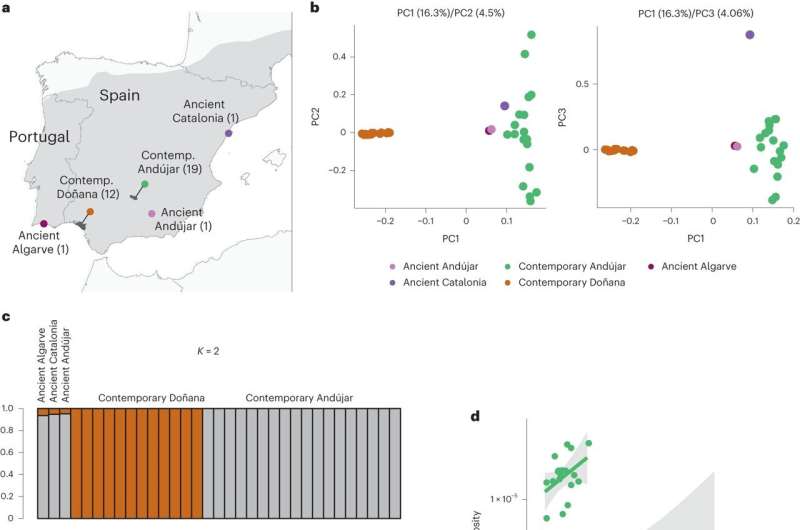This article has been reviewed according to Science X's editorial process and policies. Editors have highlighted the following attributes while ensuring the content's credibility:
fact-checked
peer-reviewed publication
trusted source
proofread
Ancient DNA study finds Iberian lynx hybridized with Eurasian lynx over the last few thousand years

Cross-species hybridization is a more frequent phenomenon than previously thought. In the past, it happened with modern humans; it is estimated that our genome contains about 2% Neanderthal DNA.
We now know that the Iberian lynx (Lynx pardinus) has also hybridized with closely related species in the recent past.
Bangor University has contributed to a new study published in Nature Ecology & Evolution on 15 January 2024. The study shows that the Iberian lynx interbred with the Eurasian lynx (Lynx lynx) over the last few thousand years. This would have helped to increase its genetic diversity and is important, given the current scenario, in which the long-term survival of the Iberian lynx is not guaranteed.
Led by Spain's Scientific research council, Consejo Superior de Investigaciones Científicas (CSIC), the scientific team analyzed the DNA of the three ancient Iberian lynx specimens: One from Andújar dated about 4,300 years ago, another from Alcanar in Catalonia dated 2,500 years ago, and another from Algarve in Portugal, dated approximately 2,100 years ago. Then they compared this information with genetic data from present-day individuals. What they observed was totally unexpected: The genetic diversity of ancient lynx was lower than that of contemporary lynx.
Dr. Axel Barlow of Bangor University's School of Environment & Natural Sciences contributed to the work. He said, "The study really demonstrates the power of ancient DNA. By looking into the past we were able to reveal a key process that shaped genetic diversity in these fascinating animals, which was undetectable when looking only at modern sources of DNA."
The increase in genetic diversity throughout history could not be explained by the historical population drift of the Iberian lynx. As its population declined over time, genetic diversity should be lower, not higher. Nor was it possible that the ancient individuals belonged to completely isolated populations, since genetic analyses showed they intermixed with each other and the ancestors of contemporary lynx. So, what could have happened in the last three or two thousand years?
The scientific team found a possible answer in hybridization.
María Lucena, first author of the study, from CSIC explains further, "The analyses revealed that modern lynx shared more genetic material with their sister species, the Eurasian lynx, than the older lynxes. This suggests that a genetic exchange has occurred between the two species during the last two thousand years."
Furthermore, the results indicate that the most recent ancient specimens of Iberian lynx, the ones from Catalonia and Algarve, have more genetic variants from the Eurasian lynx than the older one from Andújar. Thousands of years ago, the distribution of the Iberian lynx may have reached as far as the south of France and north of Italy, and the Eurasian lynx inhabited the north of the Iberian Peninsula until recent years, creating opportunities for the gene exchange between the two species. The gene flow of the Eurasian lynx to the Iberian lynx would have subsequently spread to all modern populations.
Genetic rescue
The genetic diversity of species is essential for their adaptation to changes in their environment. However, the genetic diversity of the Iberian lynx became one of the lowest in the world. The species experienced a major decline during the 20th century that left only about 100 individuals divided in two isolated, small populations in Doñana and Andújar. In response to this situation, it was decided to mix the two genetically distinct populations.
"Allowing crosses between individuals that are not at all related to each other, we avoided the inbreeding that had accumulated in the two small populations," explains José Antonio Godoy, a researcher at CSIC's Doñana Biological Station. "According to our data, it seems that the 'hybrids' of the two populations have greater reproductive success and possibly greater survival. At the same time, it also increases the genetic diversity available for adaptation to environmental changes."
Despite its successful recovery during the first decades of the 21th century, the Iberian lynx has not yet achieved a minimum population size which would ensure acceptable future genetic diversity. In another recent study, the research group calculated that at least 1,100 reproductive females were needed, while only 326 were registered in the 2022 census.
In addition, it was imperative to increase the number of subpopulations and improve connectivity between them for the genetic exchange. The LIFE-Lynxconnect project aims precisely to achieve a self-sustainable and genetically viable population of Iberian lynx in the long term, by connecting the different subpopulations and creating two new ones.
Could hybridization with other species be a solution to the low genetic diversity of endangered species, as the Iberian lynx? This option is often dismissed on the understanding that the offspring would have a lower probability of survival and reproduction, reducing the viability of the population rather than increasing it.
"In general, we expect that most of genes that enter a species from another one will have negative consequences and will be eliminated over time by natural selection, but some may restore functional variants or even allow the adaptation to new environmental conditions," explains José Antonio Godoy.
"However, we do not yet know what consequences the past gene flows we have detected in the Iberian lynx have had, and we can much less predict the consequences of future natural or intentional hybridization," he concludes. Further research in these lines will be necessary.
More information: Maria Lucena-Perez et al, Recent increase in species-wide diversity after interspecies introgression in the highly endangered Iberian lynx, Nature Ecology & Evolution (2024). DOI: 10.1038/s41559-023-02267-7
Journal information: Nature Ecology & Evolution
Provided by Bangor University




















